
Pietro Bembo, O.S.I.H. was a Venetian scholar, poet, and literary theorist who also was a member of the Knights Hospitaller, and a cardinal of the Catholic Church. As an intellectual of the Italian Renaissance, Pietro Bembo greatly influenced the development of the Tuscan dialect as a literary language for poetry and prose, which, by later codification into a standard language, became the modern Italian language. In the 16th century, Bembo's poetry, essays and books proved basic to reviving interest in the literary works of Petrarch. In the field of music, Bembo's literary writing techniques helped composers develop the techniques of musical composition that made the madrigal the most important secular music of 16th-century Italy.
This article is a list of the literary events and publications in the 15th century.
Peter John Olivi, also Pierre de Jean Olivi or Petrus Joannis Olivi, was a French Franciscan theologian and philosopher who, although he died professing the faith of the Roman Catholic Church, remained a controversial figure in the arguments surrounding poverty at the beginning of the 14th century. In large part, this was due to his view that the Franciscan vow of poverty also entailed usus pauper. While contemporary Franciscans generally agreed that usus pauper was important to the Franciscan way of life, they disagreed that it was part of their vow of poverty. His support of the rigorous view of ecclesiastical poverty played a part in the ideology of the groups coming to be known as the Spiritual Franciscans or Fraticelli.
The 1711 Sales Auction Catalogue of the Library of Sir Thomas Browne highlights the erudition of the physician, philosopher and encyclopedist, Sir Thomas Browne (1605-1682). It also illustrates the proliferation, distribution and availability of books printed throughout 17th century Europe which were purchased by the intelligentsia, aristocracy, priest, physician and educated merchant-class.
Dominicus Gundissalinus, also known as Domingo Gundisalvi or Gundisalvo, was a philosopher and translator of Arabic to Medieval Latin active in Toledo, Spain. Among his translations, Gundissalinus worked on Avicenna's Liber de philosophia prima and De anima, Ibn Gabirol's Fons vitae, and al-Ghazali's Summa theoricae philosophiae, in collaboration with the Jewish philosopher Abraham Ibn Daud and Johannes Hispanus. As a philosopher, Gundissalinus crucially contributed to the Latin assimilation of Arabic philosophy, being the first Latin thinker in receiving and developing doctrines, such as Avicenna's modal ontology or Ibn Gabirol's universal hylomorphism, that would soon be integrated into the thirteenth-century philosophical debate.
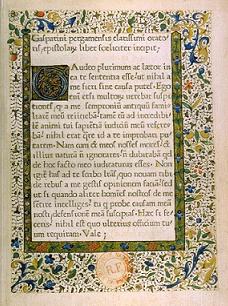
Johann Heynlin, variously spelled Heynlein, Henelyn, Henlin, Hélin, Hemlin, Hegelin, Steinlin; and translated as Jean à Lapide, Jean La Pierre , Johannes Lapideus, Johannes Lapidanus, Johannes de Lapide was a German-born scholar, humanist and theologian, who introduced the first printing press in France (Paris) in 1470.
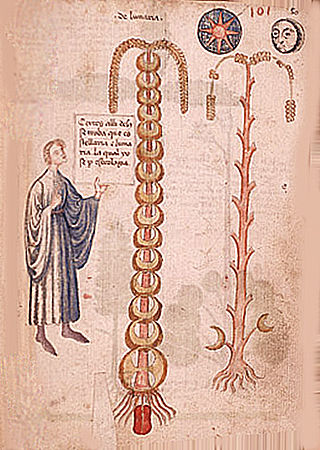
Jean de Roquetaillade, also known as John of Rupescissa, was a French Franciscan alchemist and eschatologist.
The decade of the 1530s in music involved some significant events, publications, compositions, births, and deaths.

Peeter van der Phaliesen, Latinised as Petrus Phalesius, French versions of name Pierre Phalèse and Pierre de Phaleys was a Flemish bookseller, printer and publisher. Aside from a number of literary and scientific works, his printing press is mainly known for its publications of music. Phalesius was the principal publisher of music active in the sixteenth-century Low Countries.
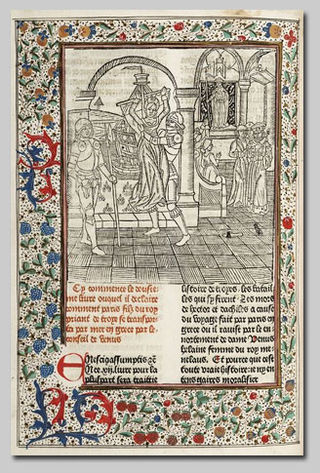
Colard Mansion was a 15th-century Flemish scribe and printer who worked together with William Caxton. He is known as the first printer of a book with copper engravings, and as the printer of the first books in English and French.

Gentile Gentili da Foligno was an Italian professor and doctor of medicine, trained at Padua and the University of Bologna, and teaching probably first at Bologna, then at the University of Perugia, Siena (1322–1324), where his annual stipend was 60 gold florins; he was called to Padua (1325–1335) by Ubertino I da Carrara, Lord of Padua, then returned to Perugia for the remainder of his career. He was among the first European physicians to perform a dissection on a human being (1341), a practice that had long been taboo in Roman times. Gentile wrote several widely copied and read texts and commentaries, notably his massive commentary covering all five books of the Canon of Medicine by the 11th-century Persian polymath Avicenna, the comprehensive encyclopedia that, in Latin translation, was fundamental to medieval medicine. Long after his death, Gentile da Foligno was remembered in the Nuremberg Chronicle (1493) as Subtilissimus rimator verborum Avicenne, "that most subtle investigator of Avicenna's teachings"
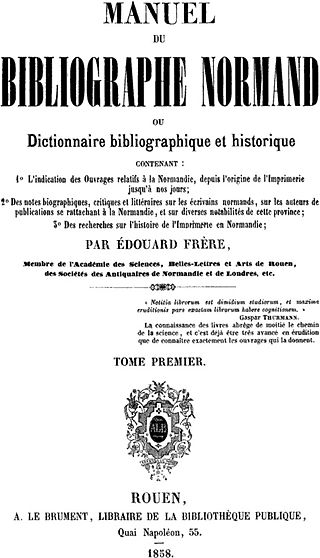
Édouard Frère was a French bookseller, archivist, biographer, and historian specialized in the Normandy area.
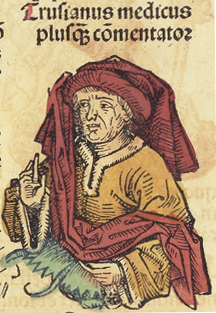
Turisanus de Turisanis was the Latin name of Pietro Torrigiano de' Torrigiani, a theoretical physician from a well-known Florentine family who taught medicine in Paris, c. 1305–19, and wrote an elaborated and influential series of commentaries on Galen's Microtechni, Plusquam commentum in Microtechni Galenii and a shorter De hypostasi urine Galeni. The two commentaries, all that survives of Torrigiani's output, were printed together by Ugo Rugerius in 1489, and in several later editions, both incunabula and 16th-century printings. The work took the conventional form of the set of quaestiones disputatae familiar in Scholasticism.
Martin Morin was a French printer of incunables, active in Rouen between about 1490 and 1518. It has been suggested that he was born in or near Orbec around 1450, and died in Rouen around 1522. He learned the trade in the Rhine region where he was sent by the Rouen family Lallemant together with Pierre Maufer, and then became a printer and bookseller in Rouen. His 1492 Breviarium Saresberiense or Breviarium Sarum, a breviary for Salisbury, is said to be "the first recorded liturgical book printed for the English market".

Guido de Monte Rochen or Guy de Montrocher was a French priest and jurist who was active around 1331. He is best known as the author of Manipulus curatorum, a handbook for parish priests, that was often copied, with some 180 complete or partial manuscripts surviving, and later reprinted throughout Europe in the next 200 years, with at least 119 printings, and sales which have been estimated to be three times those of Thomas Aquinas' Summa Theologica. It became obsolete only when the Council of Trent created the Roman Catechism in 1566.

Eustache-Hyacinthe Langlois was a French painter, draftsman, engraver and writer. He became known as the "Norman Callot". He taught both his daughter Espérance Langlois and his son Polyclès Langlois and they often assisted him with drawings and engravings.
John of Westphalia, also known as John of Paderborn, Johann von Westphalen and other spelling variations of Johannes, Paderborn and Westfalia, was the first printer in Leuven and possibly in Flanders. He was born in Paderborn or Aachen and seems to have been first active in Venice, but returned to Germany and studied at the university of Cologne before moving to Flanders as a printer. He was active from 1473 in Aalst, working together with Dirk Martens on four books, and from 1474 in Leuven. He worked there in the university until 1498, producing at least 180 books. On his death in 1498, Dirk Martens bought his shop and settled in Leuven. John's brother Conrad of Westphalia was also a printer.

Guglielmo Gratarolo or Grataroli or Guilelmus Gratarolus was an Italian doctor and alchemist.
Guillaume Pontifs was a 15th-century French master builder.
Martin Morin was a French printer of incunables, active in Rouen between about 1490 and 1518. It has been suggested that he was born in or near Orbec around 1450, and died in Rouen around 1522. He learned the trade in the Rhine region where he was sent by the Rouen family Lallemant together with Pierre Maufer, and then became a printer and bookseller in Rouen. His 1492 Breviarium Saresberiense or Breviarium Sarum, a breviary for Salisbury, is said to be "the first recorded liturgical book printed for the English market".










